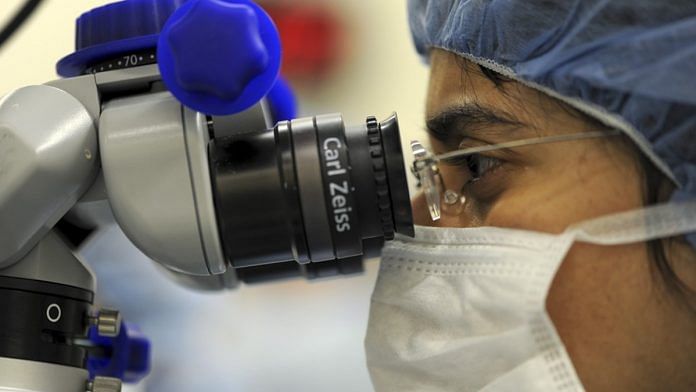New Delhi: Signs of nerve damage in the cells of the surface of eyes can help identify patients likely to suffer from ‘long Covid’, according to a new study.
Patients with ‘long Covid’ suffer from a range of potentially debilitating symptoms, including loss of smell, chronic fatigue and short-term memory loss, which continue for more than four weeks after the acute phase of the infection has passed and cannot be explained by an alternative diagnosis.
In a study, published in the British Journal of Ophthalmology Monday, researchers from Turkey and Qatar found that nerve fibre loss and an increase in key immune cells on the surface of the eye, known as cornea, could be an identifying feature of long Covid.
Nerve fibres refer to thin wires that branch off of specific nerve cells in the body and relay sensory information about pain among others to the central nervous system. Damage to these fibres can cause a wide array of symptoms.
According to the study, changes in the cornea were particularly evident among those with neurological symptoms such as loss of taste and smell, headache, dizziness, numbness and neuropathic pain after being infected with Covid-19.
It noted that about 1 in 10 Covid patients are likely to develop ‘long Covid’, and it has been suggested that small nerve fibre damage could be linked to its development.
The researchers used an imaging laser technique called corneal confocal microscopy (CCM) to pick up nerve damage in the cornea.
CCM is used to identify nerve damage and inflammatory changes linked to diabetic neuropathy, multiple sclerosis (a chronic nerve condition) and fibromyalgia — a condition characterised by body pain.
Also read: India’s Covid death rate likely to be 7-8 times higher than reported, study finds
Patients with neurological symptoms have greater corneal nerve fibre damage
For the study, 40 people who had recovered from Covid-19 — either a month or six months prior to the beginning of the research — were asked to complete a questionnaire to find out if they had long Covid.
The questionnaire collected information about respiratory, cardiovascular, neurological, musculoskeletal, psychological/psychiatric, gastrointestinal, dermatological, and ear, nose and throat symptoms.
As many as 22 patients had neurological symptoms four weeks after Covid infection while another 13 developed such symptoms 12 weeks later.
The participants’ corneas were then scanned using CCM to look for small nerve fibre damage and the density of dendritic cells. These cells have a key role in the primary immune system response by capturing and presenting antigens from invading organisms.
The corneal scans were compared with those of 30 healthy people who were not infected with Covid-19.
The corneal scans revealed that patients with neurological symptoms, four weeks after they had recovered from acute Covid-19, had greater corneal nerve fibre damage and a higher numbers of dendritic cells than those who had not been infected.
Participants whose questionnaire responses indicated that they had symptoms of long Covid also had corneal nerve fibre loss.
The authors, however, cautioned that the study was observational and did not establish the cause of nerve fibre loss.
“We show that patients with long COVID have evidence of small nerve fibre damage which relates to the severity of long COVID and neuropathic as well as musculoskeletal symptoms,” the researchers said in a statement, adding that eye tests could be used to rapidly identify patients with long Covid.
(Edited by Rachel John)
Also read: Why states/UTs didn’t report Covid deaths due to lack of O2 despite ‘oxygen shortage’ crisis






